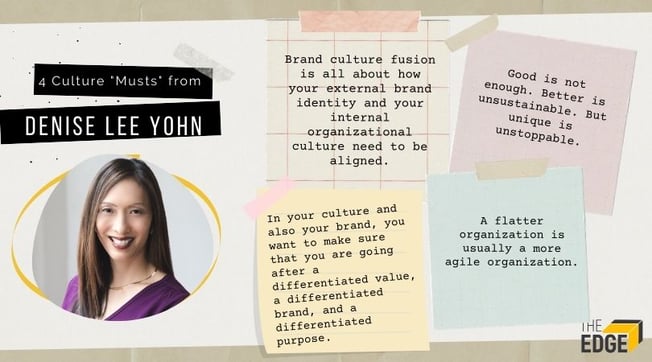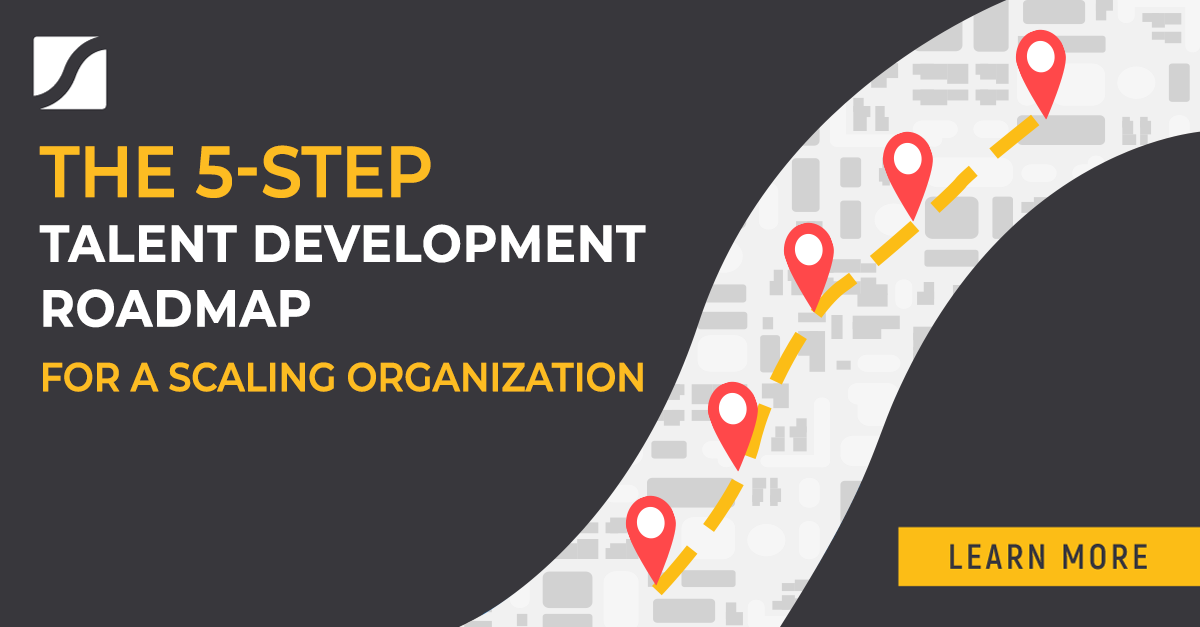6 Steps To Build a Powerful Culture That Inspires Talented Employees

Arnie Malham is a serial entrepreneur and bestselling author who's done culture wrong enough times to get it right.
This is what he has to say on the importance of culture to drive growth in your business:
“Ideas are great, but they’re a dime a dozen.
Execution is great… when you can make it work.
But Culture makes sure that ideas and execution happen on a regular basis.”
If you want to scale up your company, you first need to grow your people and inspire employees.
Why Culture Should Be A Priority In Your Company
Virtual happy hours, core values, and home office stipends alone do not make a great company culture.
In some cases, these things are only there to serve the fundamental purpose of what a great culture should do:
- Rally your team and make them feel excited, driven, and happy to give their best to the company. They want to enjoy their jobs! And so do you!
- Display to the world who your brand is and what it stands for. Your culture should be a reflection of your brand identity.
It’s getting harder and harder for companies to get away with any kind of culture-brand dissonance. The spread of information just doesn’t work that way anymore. The fusion of the internet, social media, and a workforce that is far more critical of business practices than ever before has made sure of that.
Take the case of the Wells Fargo fake account scandal in 2016 - brought to our attention by our culture and branding thought leader from The Edge, Denise Lee Yohn.  It took some exposure from one of their own employees, a special investigation led by a Senator, and the coordination of key media outlets to bring these unethical practices to light. When all was said and done, Wells Fargo had replaced their CEO, lost over 5,000 employees, and forever tarnished a reputation that had taken them decades to establish.
It took some exposure from one of their own employees, a special investigation led by a Senator, and the coordination of key media outlets to bring these unethical practices to light. When all was said and done, Wells Fargo had replaced their CEO, lost over 5,000 employees, and forever tarnished a reputation that had taken them decades to establish.
Just imagine how much faster these kinds of practices will be exposed in the coming decade!
A business with a brand-culture mismatch will not survive long in today’s market of consumers that expect more authentic brands and talented employees that want to feel purpose in their work.
So, if you want to stay competitive, attract and retain the top talent out there, and keep your business from being called out for dishonest messaging, it’s time to start talking about making culture a priority - and actually doing the work of building a powerful one.
These are the 6 pillars that will help you effectively build a strong company culture that breeds high performers.
Pillar #1 - A Strong, Healthy Culture Only Starts From The Very Top
When you first joined or founded your business, you looked to make sure all the critical pieces were there. There was a goal, a plan, and a set of benchmarks to pass along the way.
You asked yourself “Why does this business exist?” And you gave some thought to the core values you want to instill in all the talented people who join this venture.
Defining these critical values is important, because you’re able to get - and see - on paper your organization’s expectations about quality of work and attitude.
But when it comes to core values, there’s something vital that you need to understand - they don’t mean squat if the CEO or co-founder does not share and live by them.
If these core values are not aligned with the leadership of the organization, then you can’t really demonstrate what those values look like to everyone else who works there. If your CEO champions the wrong core values, employees will see an inauthentic and hypocritical message. They’ll see guidelines that are not worth taking seriously.
And who is really going to be passionate about working in this kind of atmosphere?
So this is the very first step to building a powerful culture. The values and expectations of this culture must be reflected in what the CEO and leadership believe and do. You and the leadership team need to get together and define what kind of values you want to see expressed in the organization. 
As the leader, your team and employees will look to you as the example. Because they have to! Otherwise, who else will they default to?
What kind of leader are you? What do you value?
Action Steps For Leading Culture Change:
- Take some time to reflect on your own personal values as the CEO or leader and how you live by them
- Get these down on paper and discuss with the leadership team to make sure you are aligned
- Make sure that these values are the same ones communicated throughout the organization
- If they’re not the same, fix it
Pillar #2 - Connected Employees Give You More of Their Talent and Drive...
What do you think is the single most significant driver of how engaged your employees are at work?
Metlife’s yearly study on thriving employees shows that trust is one of the elements that employees value the most.
People feel more connected and engaged at work when they know they can trust their leadership and their company.
But how does this feed into a strong culture?
David Horsager has delivered over 1,000 keynote presentations sharing the many competitive benefits of trust in leadership. He defines Trust as:
“A confident belief in a person, product, or organization”
Earning trust is about more than being transparent with your team. (Although, transparency is still incredibly important.)
To really commit their time and energy, your people need the clarity and direction that comes from earned trust. If people can confidently believe in you, it’s possible to make change happen.
Make information readily available throughout the organization. Make sure there’s a voice from the top that is flowing through your organization and making its way to all team members. At the same time, you need to make sure communication is flowing both ways to the top of the organization. If you can facilitate this kind of open, honest communication, you’ll save a lot of time and energy.
Action Steps For Building Trust To Connect Employees:
- Send out an anonymous survey to find out:
- Do your employees have trust in the leadership team?
- Are your employees satisfied with what they know about the organization, it's challenges and where it is headed?
- Do your employees feel that they have an accessible to raise their own concerns and thoughts to leadership?
- Make it a priority to get together with your team and address any concerns that come up
Pillar #3 - ...And So Do Engaged Employees
While it’s powerful to earn our employee’s trust, we also want them to be engaged in the work.
This aspiration is nothing new. Engaged employees are far more productive, happier, more creative, perform better, and take more initiative than un-engaged employees.
Yet - despite billions of dollars spent - business leaders around the world have failed to make a significant dent on the “human energy crisis”, as employee engagement speaker and expert Greg Lederman calls it.
So, how do you get your team fired up without breaking the bank?
One of the world’s foremost culture and business leadership experts, Christine Comaford, sums up this solution simply:
"The brain must do two things at work. It must have insights. Otherwise it becomes a passive order-taker. The brain must also aspire. It must say, ‘I’m here and I want to get there.’ We must give an aspiration path to the brain."
These 2 things are, essentially, the key to emotionally connected employees at work.
This need to aspire is a main reason for why a mission statement, a vision, and core values help you engage employees. These defined expectations create a focused set of behaviors for everyone on the team to aspire to, but are useless if they are not reflections of what the company’s leader believes. People will easily forget them if they are not consistently practiced and championed throughout the organization.
At Growth Institute, we display our core values clearly on our website, they are part of our onboarding process, and are things I personally work on each week, myself. Here we have 6 core values. And for each one, we say what that means.
I truly believe that learning and implementation is the recipe for success in anything you do - and it’s an attitude that I expect my team to share with me as we climb mountains.
Action Steps For Engaging Employees:
- Get clear on these questions:
- Can your employees readily explain what makes your core values so critical to the success of your organization?
- Is there a stated mission for every person on your team with clear goals and KPIs attached?
- If you find gaps, close them
Pillar #4 - Developing Employees Impress You More
At some point when running and leading your business, you realized that there is only so much you can do.
This epiphany probably came to you at a moment of intense stress and overwhelm. You discovered that no matter how driven you are, you can’t do everything at once.
That’s why entrepreneurs need to hire employees and a leadership team to help them achieve our BHAG and build a well-run company.
 Here’s what Arnie Malham had to say about growing his few businesses,
Here’s what Arnie Malham had to say about growing his few businesses,
“If our people grow, our business grows. So we go to great lengths to create growth opportunities for our team.”
The concept is pretty simple: Grow your people, and they’ll help you build a better business.
Here at Growth Institute, we are fanatical about learning, because we know it’s critical to being competitive in today’s market.
Learning and development is the only investment that’s guaranteed to bring the ROI.
I need my team’s help to bring Growth Institute to 10 million leaders, and that’s not going to happen if my employees are not on top of their game, always learning, absorbing, and keeping up with the rapid pace of change.
The bookshelf from my home office - I truly believe that learning is the best way to evolve yourself, your team, and your company.
It’s vitally important that you find a way to give your people opportunities to develop and better themselves.
It's not just employees that need to be onboard with this commitment. Leadership and middle-managers that invest themselves in learning more of what it takes to take the organization to the next level will be better prepared to spread this mindset to their own teams.
You can take a page out of the playbook of Arnie Malhalm (he won’t mind), who founded BetterBookClub.com to give his teammates the space to discuss topics they were interested in. We do something similar here at Growth Institute with our monthly Lunch ‘n Learns using courses straight from The Edge.
What makes these types of initiatives easy is that today’s talent actively craves and seeks opportunities for growth. People want to have insights about themselves and the world, so they can better prepare themselves to succeed as professionals, and as individuals. Helping them get there faster is the best way to stand out from the crowd.
There are several different ways you can go about this - but the most important thing is to get started.
Action Steps For Supporting Employee Learning and Development:
- Verify that this learning and growth mindset is embedded in your organization’s core values
- Ask your team members what they would like to learn
- And then, get them the resources and support to help them learn that
- Consider how a Talent Development Roadmap can help your team develop themselves
Pillar #5 - Happy Employees Reduce Drama
Are you happy at work?
What about your team members and your employees?
The pure benefit of having happy, healthy employees in your organization should be so blatantly apparent that no endorsement from a noted expert is necessary.
Having said that, here’s what leadership and mindfulness expert Oksana Esberard has to say about how employee health factors into the business -
“The cost of not paying attention and not addressing mental health issues in your company is actually very high. There are 30-40% of burnout costs from employees quitting because the emotional pressure is so high. Employees can lose 1 or 2 hours of productivity because they are just battling with their own emotions. ”
You can list out a number of things that you know make people happy at work. People generally feel happy when they feel respected, when they are able to collaborate, when they are recognized for their effort, when they feel excited, and when they have strong social ties. 
In his bestseller CRAVE, employee engagement expert Greg Ledderman breaks down the things that make people happy into 3 categories of basic human social needs:
- The need to have Respect,
- The need to feel Purpose, and
- The need to maintain good Relationships
We’ve already covered the need for Purpose in the form of defining core values, maintaining a strong and aligned leadership, and providing employees opportunities to chart their own growth and development through learning initiatives.
But what about the need for Respect and Relationships?
That’s where simple habits like recognition, praise, and appreciation play their part.
People place a lot of importance on their reputation in their organizations. They want to be recognized for their efforts. They also want to be treated fairly. They want their performance judged according to a standard baseline.
That’s why, when you do give recognition, you want to do it publicly, you want to be specific, and you want it to be earned. Don’t give out praise arbitrarily.
For example: “Hey Susan, thank you for demonstrating strong accountability in this project that we just wrapped up. And thank you for helping Mark and Joy get all their ‘stucks’ resolved quickly and efficiently. It’s this kind of initiative that really helps us pull forward as a team.”
To take this even further, give everyone in the organization the freedom to dole out praise and recognition where they see fit. If your core values have been defined, if your leadership team lives by these values, and if they are easily understood throughout the organization, then this public recognition will serve to amplify your culture.
Are you cheering for your people? Are they cheering for each other? Is there a system in place where people can praise each other?
Get into the habit of praising your team for aligning with core values, and you will begin to see increased performance to model this behavior.
Action Steps For Increasing Employee Happiness:
- If you’re not already showing appreciation publicly and specifically, come up with just 1 way you can start doing this on a regular basis
- Choose and stick to a time every week (as long or short as you need) to come up with better ways to strategically recognize your employees
- Get a pulse on your employee’s happiness
- A company-wide (anonymous) survey should do the trick
- Or just check-in with your team and ask, “Hey guys, thumbs up or thumbs down? How do you feel?”
Pillar #6 - Culture Building Has To Be Deliberate
Now, we get to the most important point to build a great culture.
Culture does not happen by default. It has to be designed.
Ultimately, it is the job of you and your leadership team to define what that culture needs to look like and set a course for how to get there.
It is your job to make sure your employees are finding it easy in your organization to engage, grow, and contribute in a happy and healthy way.
Then the nuts and bolts of how to get there - the initiatives, the programs, the workshops - will always work faster if culture-building is a collaborative effort that involves everyone in the organization.
Encourage your team and your people to try out different systems that reflect your ideal culture. Inspire them to take the charge. Give them the support and the resources they need - and then step back to let them make it happen.
Action Steps For Making Culture Building Deliberate:
- Assign a Culture Champion to build out your company’s culture
- Give this person the resources and freedom they need to build systems and processes
- Get comfortable with having to fail many times to get it right
- Champion your Champion - Let the company know when you support your Champion’s initiative
- Make your core values and priorities VISIBLE
Final Thoughts
A great culture will do wonders for your business.
Done right, your culture will help you stand out from the competition in the arenas of hiring, marketing, and public reputation.
All it takes is intent, planning, and ability to follow-through.
Learn And Develop With Your Team In Just 10 Minutes A Day
The Edge is designed for busy leaders and entrepreneurs who seek the most relevant business education to scale their companies.
With The Edge, you’ll get the tools to faster results, confident execution, and a well-trained team in just 10 minutes a day!
Discover how flexible and easy it is to strengthen your leadership skills.
Learn how you continuously push your leadership with The Edge today.





